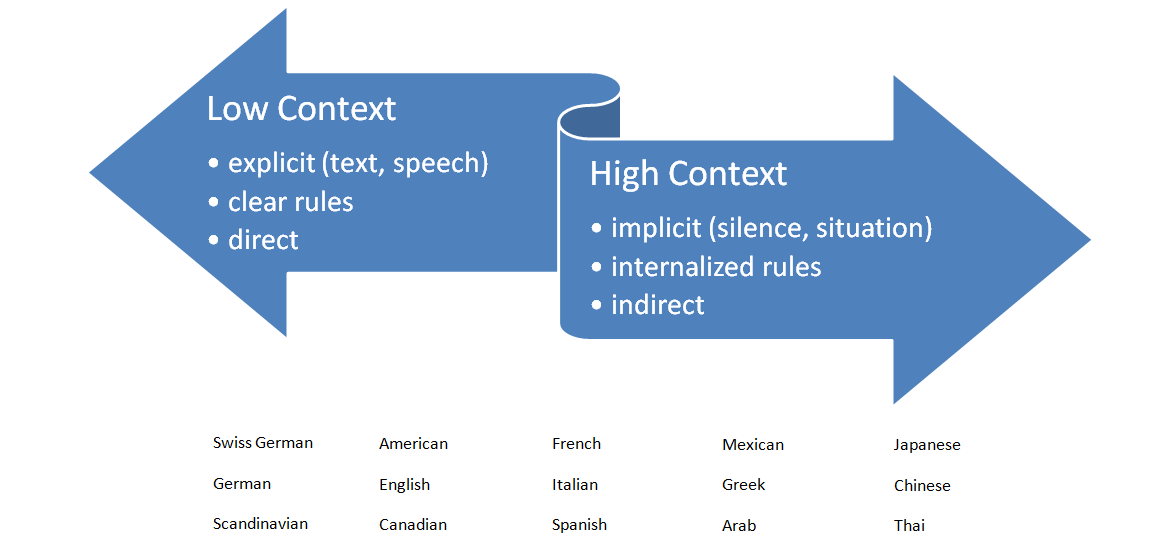Imagine walking into a meeting in a new country. You’re excited to connect with your colleagues, but as you launch into your presentation, you notice a puzzled look on everyone’s faces. They seem disinterested, maybe even a bit offended. You later learn that your direct and straightforward approach came across as aggressive and disrespectful. This scenario highlights the complexities of communication, particularly across different cultures. One key factor influencing these differences is a concept called “context.”

Image: www.linkedin.com
Understanding low-context culture is crucial in today’s globalized world. It helps us navigate intercultural interactions with greater sensitivity and effectiveness. This article delves into the fascinating world of low-context culture, exploring its characteristics, origins, and implications for personal and professional life.
Decoding Low-Context Culture: What Makes It Unique?
Low-context culture, simply put, thrives on explicit communication. In these cultures, people rely heavily on verbal messages and clear instructions to convey their meanings. Think of it as a direct, no-nonsense approach to communication.
In low-context cultures, individuals value being upfront, clear, and concise in their communication style. They prefer explicit information, leaving little room for interpretation. This approach emphasizes individualistic values, with a strong focus on self-expression and personal achievement.
Origins and Historical Influence on Low-Context Culture: A Glimpse into the Past
The roots of low-context culture can be traced back to several factors. Historically, societies with large-scale migration, diverse populations, and rapid societal changes often developed low-context communication styles. These factors created environments where clear and precise communication was essential for effective interaction among people from different backgrounds.
For example, the United States, with its diverse immigrant population and focus on individual achievement, is often cited as a prime example of a low-context culture. Similarly, Northern European countries like Germany and Scandinavia also tend to exhibit low-context communication characteristics.
Characteristics of Low-Context Culture: Unpacking the Nuances
To illustrate the characteristics of low-context culture, let’s delve into some key traits:
- Explicit Language: In low-context cultures, communication is direct and straightforward. The focus is on verbal clarity, with a preference for explicit statements that leave no room for ambiguity.
- Value of Individualism: Low-context cultures often emphasize individual values, self-reliance, and personal achievement. These societies encourage individual expression and prioritize clear communication to achieve individual goals.
- Focus on Task-Oriented Communication: These cultures often prioritize efficiency and effectiveness. Communication is primarily focused on accomplishing tasks, with less emphasis on building relationships or social niceties.
- Importance of Written Communication: Written communication, like emails and contracts, takes precedence in low-context cultures. Formal written communication ensures clarity, transparency, and accountability.

Image: www.sketchbubble.com
The Impact of Low-Context Culture on Communication: Real-World Implications
The influence of low-context culture extends far beyond communication styles. It permeates various aspects of life, including business practices, education, and even personal relationships:
- Negotiations and Business Deals: In low-context business environments, detailed contracts, clear agreements, and written documentation are crucial. The emphasis on explicit information ensures clarity and minimizes misunderstandings.
- Education and Training: Educational systems in low-context cultures tend to be structured and hierarchical. Teachers often rely on lectures, clear instructions, and assessments to convey knowledge effectively.
- Personal Relationships: While friendships and relationships can be strong, the focus in low-context cultures often lies on individual independence. People may be direct and straightforward in expressing their feelings, prioritizing clarity and honesty.
Navigating Intercultural Communication: Tips for Success
Living in a globalized world requires us to navigate intercultural interactions with sensitivity and understanding. Here are some practical tips to help you communicate effectively in low-context environments:
- Be Direct and Concise: Embrace clear and straightforward communication. Avoid ambiguity or assumptions and state your points explicitly.
- Listen Actively: Pay attention to both verbal and non-verbal cues. Seek clarification when needed and show genuine interest in others’ perspectives.
- Use Visual Aids: In low-context cultures, visuals like presentations, diagrams, and written instructions can enhance communication and reduce misunderstandings.
- Respect Cultural Differences: Recognize that communication styles vary globally. Approach intercultural interactions with a spirit of openness and respect for different cultural norms.
Expert Insights: Navigating Communication Challenges
Dr. Sarah Jones, a renowned intercultural communication expert, emphasizes the importance of building rapport in low-context environments. She suggests: “While direct communication is valued in low-context settings, it’s essential to build trust and relationships with your counterparts. Take the time to engage in small talk, show interest in their culture, and build connections beyond the immediate task at hand.”
What Is Low Context Culture
Concluding Thoughts: Embracing Cultural Diversity
Understanding low-context culture is a powerful tool for navigating a globalized world. It empowers us to communicate effectively across cultural boundaries, foster deeper connections, and achieve meaningful outcomes. By embracing cultural diversity and appreciating different communication styles, we can build bridges of understanding and collaboration, contributing to a more interconnected and harmonious world.
Remember: When venturing into new cultural territories, embrace the spirit of curiosity, remain open-minded, and always be willing to learn. This journey of cultural understanding is a lifelong adventure, filled with rich discoveries and rewarding experiences.



/GettyImages-173599369-58ad68f83df78c345b829dfc.jpg?w=740&resize=740,414&ssl=1)


